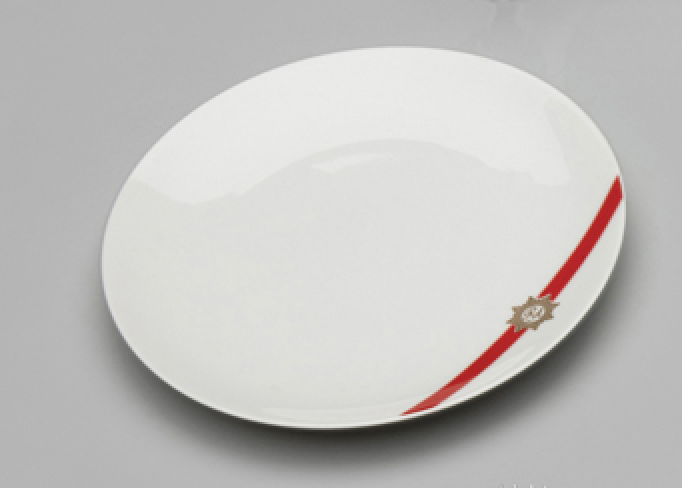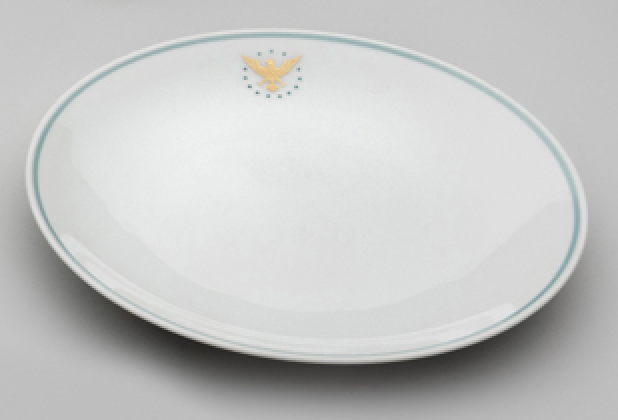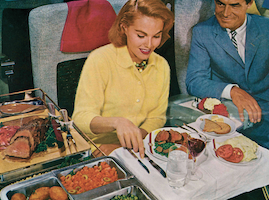
SAN FRANCISCO – Through June 26, the SFO Museum will present More than a Meal: Airline Meal Service Sets, 1960s–80s, an exhibition on how airlines competed for, and pampered, their elite customers with top-notch food and drink, presented on custom-commissioned fine china and flatware services.
During the early years of commercial flight, the nourishment and hydration needs of passengers became a primary focus for nascent airlines. In 1919, Handley Page Transport served the first inflight meal on a flight from London to Paris in a World War I bomber modified for passenger use. By the 1920s, some European carriers were offering sophisticated restaurant-style meals that included lobster, ox tongue, roasted chicken, foie gras, and peaches with Melba sauce. In the United States, airline staff initially handed out box lunches of fried chicken and apples to boarding passengers, or the copilot served cold sandwiches and tepid coffee during the flight.

During the 1930s, Pan American Airways and Imperial Airways equipped their transoceanic flying boats with kitchens and passenger dining rooms, where premium meals were served on fine china. One of the first land-based airliners designed with a galley for food preparation was the Douglas DC-3, introduced in 1936. During this time, the airlines used onboard dishes designed to be lightweight due to the limited payload capabilities of these early propliners. In the postwar era, as air travel rapidly increased, aircraft manufacturers designed new airliners with food service in mind. Airlines began developing distinct food and beverage programs, and meal services became a highly competitive aspect of their in-flight offerings. Carriers often marketed these services with alluring promotions and developed elegant menus to distinguish themselves and entice passengers with their cuisine.

To provide a restaurant-style in-flight dining experience, airlines also considered the tableware comprising the meal service set. They carefully conceived their chinaware, flatware and glassware for presentation, utilization, storage and durability. Manufacturers often created tableware bearing the airline’s service mark or logo, as well as unique patterns related to national origin, destination or service promotions. This exhibition presents eight airline meal service sets from the 1960s to the 1980s, along with menus and images of in-flight meal services from the time.
Among the included examples are:
China Airlines Blue Lotus
Established in 1959 by the Republic of China in Taiwan, China Airlines initially focused on charter flights, and began scheduled regional services in 1962. In 1970, after the acquisition of several Boeing 707 jetliners, the carrier initiated transpacific flights to San Francisco. During this decade, China Airlines provided premium meal services on blue-and-white china sets with a traditional Chinese lotus motif. The production of cobalt blue-and-white ware in China dates to the Tang dynasty (618-907 A.D.) and, during the next millennium, became one of the most well-known types of Chinese ceramics.

The airline used select china pieces for Western- and Asian-style meals. The Western-style meals were offered with plates, coffee cups and saucers and metal flatware, while the Asian-style meals were served with soup and rice bowls, a tea service, soup spoons and chopsticks. On flights between San Francisco and Taipei, China Airlines presented its passengers with a choice of buttered beef filet, duchess potatoes and buttered broccoli, or sweet and sour pork with noodles and snow peas.
TWA (Trans World Airlines) Royal Ambassador
Originally created through a merger as Transcontinental & Western Air in 1930, TWA was renamed Trans World Airlines during the early postwar era as it expanded into international routes. In 1959, the airline introduced jet flights to Europe, and soon after, launched its Royal Ambassador international first-class service. It was promoted by TWA as “the finest passenger service ever offered to airline travelers.” The Rosenthal China Company of Germany was contracted to create fine bone china tableware with a distinctive ambassadorial red sash and medallion design surrounding the cursive initials “RA.”

This china pattern was so popular that TWA made it available for sale to the public through inflight catalogs. This set included embossed entree, bread and side plates, along with a bowl and a demitasse cup with saucer. TWA also included Swedish glassware with the Royal Ambassador medallion and salt and pepper shakers. International Silver Company produced flatware with a distinctive flowing, curvilinear pattern and the carrier’s TWA service mark. As the name of the pattern suggests, it was designed to create a dining experience fit for an international dignitary, with cuisine offerings similar to a gourmet restaurant, including Chateaubriand served from the cart, veal piccata, and lobster thermidor.
Pan American World Airways President
From its humble beginnings in 1927, with one airmail contract to Cuba and a single leased plane, Pan American Airways rapidly expanded in the 1930s under the leadership of Juan T. Trippe as it pioneered a worldwide overseas route system that included the Caribbean, South America, China, New Zealand and Europe. By the 1940s, the airline rebranded itself as Pan American World Airways to reflect its global identity. In 1958, it became the first airline to launch Boeing 707 jet service to Europe. Several years later, the airline introduced the President pattern meal service set for its first-class international jet service.

Noritake of Japan created the ceramic dinnerware featuring an eagle with three gold stars above its head and 10 gold stars under its spread wings. A blue line adorned the rims, and the eagle design was replicated on the glasses. The flatware was produced by the International Silver Company with Pan American’s jet-age globe logo on the handle of each piece. Maxim’s of Paris was contracted to prepare special menus for Pan American’s first-class service. Dinner included hors d’oeuvres and drink carts followed by a carving station offering roast beef for a main course, a dessert selection, and after-dinner cheese platters and liqueurs.
Visit www.sfomuseum.org/exhibitions/airline-meal-service for more information about the exhibition.
More than a Meal: Airline Meal Service Sets, 1960s–80s is located pre-security in the Mayor Edwin M. Lee International Departures Hall, San Francisco International Airport. This exhibition is on view to all airport visitors through June 26. There is no charge to view the exhibition.
About SFO Museum
Established in 1980 by the Airport Commission, SFO Museum’s mission is to delight, engage and inspire a global audience with programming on a broad range of subjects; to collect, preserve, interpret and share the history of commercial aviation; and to enrich the public experience at San Francisco International Airport. The museum has been accredited by the American Alliance of Museums since 1999 and retains the distinction of being the only accredited museum in an airport.
Today, SFO Museum operates more than 25 sites throughout the airport terminals, including 14 galleries that exhibit a rotating schedule of art, history, photography, science and cultural exhibitions. Among the sites is the San Francisco Airport Commission Aviation Library and Louis A. Turpen Aviation Museum, which houses a permanent collection of more than 150,000 objects related to the history of commercial aviation. To browse current and past exhibitions, research our collection or for more information, please visit www.sfomuseum.org.



